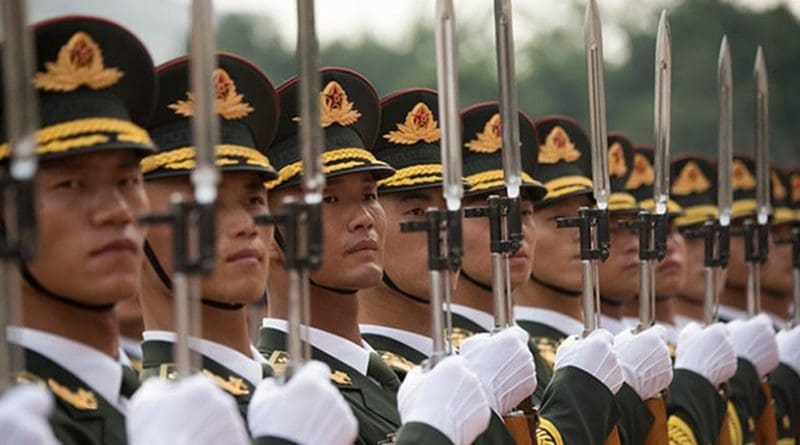China’s Military Budget: No Need For Alarm Yet – Analysis
By James Char*
At China’s 13th National People’s Congress (NPC) in March 2021, Beijing set aside funds for a 6.8 per cent increase in national defence spending over the next year — totalling some 1.35 trillion RMB (US$210 billion). Some media accounts took this as an indicator of Beijing’s readiness for war, but the counterargument is that the Chinese Communist Party (CCP) continues to see a strategic window to upgrade its People’s Liberation Army (PLA), which still lags behind the better-equipped and more experienced US military.
Given the lack of disaggregated data in the annual PLA budget and the antecedent diversion of funds from the State Council towards indigenous weapons research, China’s actual military spending exceeds official statistics. Although the gap has decreased over time, current estimates still place the PLA’s actual expenditure at 1.36 per cent greater than the official figures.
The CCP leadership allocates this budget based on an ‘economic-military development’ principle. Since the beginning of China’s economic liberalisation under Deng Xiaoping, the PLA’s fortunes have been inextricably linked with the country’s economic development. In particular, the PLA leadership had to be placated when Deng initially ordered their professional interests to be subordinated to the civilian economy so as to free up resources.
Since then, the PLA has received ever greater economic resources. Even though military expenditure as a proportion of China’s official GDP has fallen since 2000 to around 1.3 per cent, the country’s substantial economic expansion means that actual PLA budget has grown larger in absolute terms. Given the Chinese government has set a growth target of 6 per cent for 2021, the PLA’s budget increase of 6.8 per cent may well continue to be coordinated with Chinese GDP.
This year’s work report from the NPC stands out with its increased attention to the PLA’s personnel. In stressing ‘national defence and the armed forces’, the government has proclaimed that authorities ‘at all levels’ would ‘vigorously’ support their development. An emphasis on soldiers’ welfare might be further proof that Chinese defence spending will increasingly be geared towards personnel and training, the two major components of the budget alongside equipment costs.
According to the Stockholm International Peace Research Institute, economic compensation for demobilised and retired Chinese veterans in 2019 alone was estimated at 139.8 billion RMB (US$21.4 billion), almost 12 per cent of the official military budget that year. Though troop numbers were recently reduced by 300,000, cost reductions will likely be balanced out by increased expenditure on salaries, food and insurance for those still serving, as well as upgrades to training and sustainment.
Indeed, the PLA reforms launched under Chinese leader Xi Jinping in his capacity as Central Military Commission Chairman now seem more focused on upgrading its human elements. On 28 January the country’s Ministry of National Defense announced a major policy shift from a ‘grade-centric’ to ‘rank-centric’ officer management system. PLA career tracks and their remuneration packages have also been clarified to further incentivise the country’s best and brightest to join their ranks. But, for the PLA to compete effectively with China’s private sector, such initiatives will not come cheaply.
Although top PLA generals have called for greater spending to confront the so-called Thucydides Trap with the United States, war remains unlikely in the near to medium-term. Given the PLA’s shortcomings — particularly in combined arms and joint operations — it stands to reason that Beijing possesses neither the wherewithal nor the desire to initiate war against Washington, especially on matters outside its core interests. And despite exponential growth in China’s military spending, now the world’s second largest, it remains about a third of Washington’s. A more worrying concern is that aggressive interactions between China’s armed forces and others in the region could go awry and escalate into a full-blown conflict.
As President Xi Jinping is only too aware, the former Soviet Union disintegrated largely due to its over-militarised national economy. As such, the principles of subordination and coordination in China’s economic-military development will likely continue, even if the PLA has gained greater prominence under Xi.
China’s military activities this past decade and its more recent ‘Wolf Warrior’ diplomacy suggest Beijing will unlikely be a benign hegemon should it somehow reach power parity with Washington. But to suggest that the PLA is now ready to challenge the incumbent world-class military — as some media reports have done — is neither accurate nor helpful in making sense of ongoing developments in the Chinese military.
*About the author: James Char is an Associate Research Fellow with the China Programme at the S. Rajaratnam School of International Studies (RSIS), Nanyang Technological University, Singapore. He is the editor of The People’s Liberation Army in Its Tenth Decade, Journal of Strategic Studies, Volume 44, Issue 2 (2021). He thanks Dennis Blasko and Kenneth Allen for their valuable insights and useful sources.
Source: This article was published by East Asia Forum

